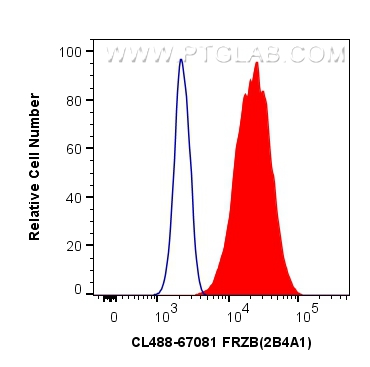验证数据展示
经过测试的应用
| Positive FC (Intra) detected in | Neuro-2a cells |
推荐稀释比
| 应用 | 推荐稀释比 |
|---|---|
| Flow Cytometry (FC) (INTRA) | FC (INTRA) : 0.40 ug per 10^6 cells in a 100 µl suspension |
| It is recommended that this reagent should be titrated in each testing system to obtain optimal results. | |
| Sample-dependent, Check data in validation data gallery. | |
产品信息
CL488-67081 targets FRZB in FC (Intra) applications and shows reactivity with human, mouse samples.
| 经测试应用 | FC (Intra) Application Description |
| 经测试反应性 | human, mouse |
| 免疫原 | FRZB fusion protein Ag28147 种属同源性预测 |
| 宿主/亚型 | Mouse / IgG1 |
| 抗体类别 | Monoclonal |
| 产品类型 | Antibody |
| 全称 | frizzled-related protein |
| 别名 | Frizzled related protein 1, FRITZ, Frezzled, FRE, FIZ |
| 计算分子量 | 325 aa, 36 kDa |
| 观测分子量 | 36 kDa |
| GenBank蛋白编号 | BC027855 |
| 基因名称 | FRZB |
| Gene ID (NCBI) | 2487 |
| RRID | AB_3084306 |
| 偶联类型 | CoraLite® Plus 488 Fluorescent Dye |
| 最大激发/发射波长 | 493 nm / 522 nm |
| 形式 | Liquid |
| 纯化方式 | Protein G purification |
| UNIPROT ID | Q92765 |
| 储存缓冲液 | PBS with 50% glycerol, 0.05% Proclin300, 0.5% BSA, pH 7.3. |
| 储存条件 | Store at -20°C. Avoid exposure to light. Stable for one year after shipment. Aliquoting is unnecessary for -20oC storage. |
背景介绍
Frzb (also known as sFRP3) is a member of the secreted frizzled related protein (SFRP) family, originally identified as a chondrogenic factor during bone morphogenesis (PMID: 29209231). It was subsequently shown to be a regulator in Wnt signaling, and also have a role in regulating cell growth and differentiation in specific cell types. FRZB was seen to be acting as an oncogene in some cancer, such as metastatic renal cancer.
实验方案
| Product Specific Protocols | |
|---|---|
| FC protocol for CL Plus 488 FRZB antibody CL488-67081 | Download protocol |
| Standard Protocols | |
|---|---|
| Click here to view our Standard Protocols |
